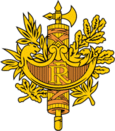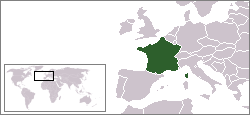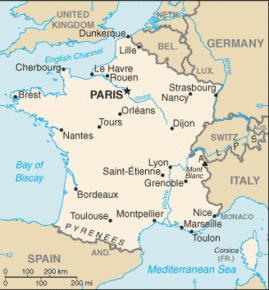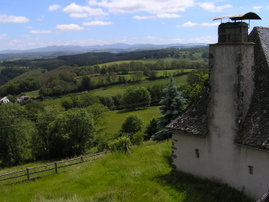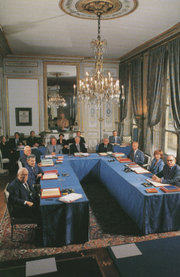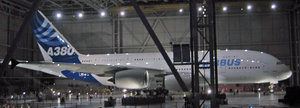France
From Wikipedia, the free encyclopedia.
|
||||||||||||||||||||||||||||||||||||||||
The French Republic or France (French: République française or France) is a country whose metropolitan territory is located in Western Europe, but which also includes territories located in other continents. France extends from the Mediterranean Sea to the English Channel and the North Sea, and from the Rhine River to the Atlantic Ocean. Because of its shape, Metropolitan France is known by Frenchmen as "the Hexagon". It is bordered by Belgium, Luxembourg, Germany, Switzerland, Italy, Monaco, Andorra, and Spain. It is across the English Channel from the United Kingdom. Because of French Guiana, the French Republic also shares land borders overseas with Brazil, Suriname, and the Netherlands Antilles.
France is a democracy organised as a unitary semi-presidential republic. It is a developed country with the fifth-largest economy in the world in 2004.[1] Its main ideals are expressed in the Declaration of the Rights of Man and of the Citizen. France is one of the founding members of the European Union, and has the largest land area of all members. France is also a founding member of the United Nations. It is one of the five permanent members of the United Nations Security Council wielding veto power, and it is also one of only eight acknowledged nuclear powers.
The name France comes from the Franks, the Germanic tribe that occupied the region after the fall of the Roman Empire, and, more precisely the region around Paris called Île-de-France which was the centre of the French royal dominion.
Contents |
Geography
- Main article: Geography of France
While the main territory of France (metropolitan France; French: la Métropole, or France métropolitaine) is located in Western Europe, France is also constituted from territories in North America, the Caribbean, South America, the western and southern Indian Ocean, the northern and southern Pacific Ocean, and Antarctica (sovereignty claims in Antarctica are not recognised by most countries, see Antarctic Treaty System).
Metropolitan France possesses a large variety of landscapes, ranging from coastal plains in the north and west, where France borders the North Sea and the Atlantic Ocean, to the Pyrenees mountains in the south-west and the Alps in the south-east, the latter containing the highest point in western Europe, Mont Blanc at 4810 m. In between are found other elevated regions such as the Massif Central, the Jura, the Vosges, or the Ardennes which are quite rocky and forested, as well as extensive river basins such as those of the Loire River, the Rhône River, the Garonne and Seine.
Due to its numerous overseas departments and territories scattered on all oceans of the planet, France possesses the second-largest Exclusive Economic Zone (EEZ) in the world, covering 11,035,000 km² (4,260,000 mi²), just behind the EEZ of the United States (11,351,000 km² / 4,383,000 mi²), but ahead of the EEZ of Australia (8,232,000 km² / 3,178,000 mi²).[2] The EEZ of France covers approximately 8% of the total surface of all the EEZs of the world, whereas the land area of the French Republic is only 0.45% of the total land area of the Earth.
History
- Main article: History of France

The borders of modern France roughy align with those of the ancient territory of Gaul, inhabited by Celts known also as Gauls. Gaul was conquered by the Romans in the first century BC, and the Gauls eventually adopted Roman speech and culture. Christianity also took root in the second and third centuries AD. Gaul's eastern frontiers along the Rhine were overrun by Germanic tribes in the fourth century AD, principally the Franks, from whom the ancient name of "Francie" derived. The modern name "France" derives from the name of the feudal domain of the Capetian Kings of France around Paris. Existence as a separate entity begins with the division, in 843, of Charlemagne's Carolingian empire into eastern, central and western parts. The eastern part (which would soon unite with the central portion as the Holy Roman Empire) can roughly be regarded as the beginnings of what is now Germany, the western part, that of France.
Charlemagne's descendants ruled France until 987, when Hugh Capet, Duke of France and Count of Paris, was crowned King of France. His descendants, the Capetian, Valois and Bourbon dynasties unified progressively the country within the royal dominion after a sequence of wars and dynastic inheritance. The monarchy reached its height during the 17th century and the reign of Louis XIV. At this time France had a tremendous influence over the European politics, economy and culture.
The monarchy ruled France until 1792, when the French Revolution established the French First Republic. Napoleon Bonaparte seized control of the republic in 1799, making himself First Consul. His armies engaged in several wars across Europe, conquered many countries and established new kingdoms with Napoleon's family members at the helm. Following his defeat in 1815, the French monarchy was re-established. In 1830, a civil uprising established the constitutional July Monarchy followed by the Second Republic in 1848. The short-lived Second Republic ended when the late Emperor's nephew, Louis-Napoléon Bonaparte, was elected President and proclaimed a Second Empire in 1852. Louis-Napoléon was ultimately unseated following the Franco-Prussian war in 1870. The Third Republic was then established.
Although ultimately a victor in both World War I and World War II, France suffered extensive losses in its empire, comparative economic status, working population, and status as a dominant nation state. After World War II, the Fourth Republic was established. In 1958, the current semi-presidential Fifth Republic was established under the leadership of General de Gaulle.
In recent decades, France's reconciliation and cooperation with Germany have proved central to the political and economic integration of Europe, including the introduction of the Euro in January 1999. France has been at the forefront of European states seeking to exploit the momentum of monetary union to advance the creation of a more unified and capable European political, defence and security apparatus. However its population voted against ratification of the European Constitutional Treaty in May 2005.
As of November 9, 2005 the French Republic was placed under a State of Emergency by president Jacques Chirac, in an attempt to gain control over the 2005 French riots.
Government and politics
- Main articles: Government of France, Politics of France
The constitution of the Fifth Republic was approved by referendum on September 28, 1958. It greatly strengthened the authority of the executive in relation to Parliament.
Under the constitution of France, the President of France is elected directly by the public for a 5-year (originally 7-year) term. Presidential arbitration assures regular functioning of the public powers and the continuity of the state. The president names the prime minister, presides over the cabinet, commands the armed forces, and concludes treaties.
The National Assembly (Assemblée Nationale) is the principal legislative body. Its deputies are directly elected to 5-year terms, and all seats are voted on in each election. The Assembly has the power to dismiss the cabinet, and thus the majority in the Assembly determines the choice of government. Senators are chosen by an electoral college for 6-year terms, and one half of the Senate is renewed every 3 years starting in 2007.[3] The Senate's legislative powers are limited; the National Assembly has the last word in the event of a disagreement between the two houses, except for constitutional laws (amendments to the constitution & "lois organiques"). The government has a strong influence in shaping the agenda of Parliament.
French politics, for the past 30 years, have been characterised by the opposition of two political groups: one left-wing, centred around the French Socialist Party, and one right-wing, centred around the Rassemblement pour la République (RPR), then its successor the Union pour un Mouvement Populaire (UMP). The Front National nationalist / hard right party, seizing on voters' growing concerns of their country's perceived decline, as well as 'national dissolution' brought about by immigration and globalisation, and advocating tougher law-and-order and immigration policies, has made inroads since the early 1980s, but has lately remained stable at around 16% of the votes.
France's founding membership in the European Union has largely defined France's foreign policy. On May 29, 2005 the French rejected the referendum to decide whether their country should ratify the proposed Treaty establishing a Constitution for Europe with approximately 55% voting no. The outcome of the vote was widely regarded as crucial for the future development of the EU, as well as for France's ability to retain its position of leadership in Europe. The French Republic is furthermore a member of the Secretariat of the Pacific Community (SPC) and of the Indian Ocean Commission (COI), and an associate member of the Association of Caribbean States (ACS). France is also a leading member of the International Organisation of Francophonie (OIF) which gathers 51 fully or partly French-speaking countries.
France hosts the headquarters of the OECD and UNESCO, as well as those of the International Bureau for Weights and Measures in charge of the international metric system, and Interpol.
Administrative divisions
- Main article: Administrative divisions of France
France has 26 régions: 21 of these are in the continental part of metropolitan France, one is Corse on the island of Corsica (although strictly speaking Corse is in fact a "territorial collectivity", not a région, but is referred to as a région in common speech), 4 are overseas. The régions are further subdivided into 100 départements. The departments are numbered (mainly alphabetically) and this number is used, for instance, in postal codes and vehicle number plates.
The departments are further subdivided into 342 arrondissements, but they have no elected assembly and serve only for the districting of state administrations. The arrondissements are further divided into 4,035 cantons, but again these serve only administrative and electoral purposes. Finally, the arrondissements are divided into 36,682 communes, which are all municipalities with an elected assembly (municipal council).
The régions, départements, and communes are known as territorial collectivities (collectivités territoriales), and they possess local assemblies as well as an executive, while the arrondissements and the cantons are mere administrative divisions. Until 1940, the arrondissements were also territorial collectivities with an elected assembly (arrondissement council), but these were suspended by the Vichy regime and definitely abolished by the Fourth Republic in 1946. Anciently, the cantons were also territorial collectivities with each their own elected assembly.
Four of these 100 départements are overseas départements, which are former colonies outside metropolitan France that now enjoy a status similar to European or metropolitan France. They are considered to be a part of France (and the EU) rather than dependent territories, and each of them is an overseas région at the same time.
In addition to the 26 régions and 100 départements, the French Republic is further made up of overseas territories, overseas countries, departmental collectivities, and overseas collectivities.
Overseas territories and countries form part of the French Republic, but do not form part of the Republic's European territory or the EU fiscal area. The Pacific ocean territories continue to use the French Pacific Franc as their currency, which was not replaced by the euro like the French franc was in 2002. The French Pacific Franc's value is, however, now tied to that of the euro. The overseas "départements", on the other hand, used the French franc and now use the euro.
The departmental and overseas collectivities have an intermediate status between overseas départements and overseas territories.
France also maintains control over a number of small non permanently inhabited islands in the Indian Ocean and the Pacific Ocean: Bassas da India, Clipperton Island, Europa Island, Glorioso Islands, Juan de Nova Island, Tromelin Island. See Islands controlled by France in the Indian and Pacific oceans.
Economy
- Main article: Economy of France
France's economy combines extensive private enterprise (nearly 2.5 million companies registered) with substantial (though declining) government intervention (see dirigisme). The government retains considerable influence over key segments of infrastructure sectors, with majority ownership of railway, electricity, aircraft, and telecommunication firms. It has been gradually relaxing its control over these sectors since the early 1990s. The government is slowly selling off holdings in France Télécom, Air France, as well as the insurance, banking, and defence industries.
A member of the G8 group of leading industrialised countries, it ranked as the fifth-largest economy in the world in 2004, behind the United States, Japan, Germany, and the United Kingdom. France joined 10 other EU members to launch the Euro on January 1, 1999, with euro coins and banknotes completely replacing the French franc in early 2002.
According to the OECD, in 2004 France was the world's fifth-largest exporter of manufactured goods, behind the United States, Germany, Japan, and China, (but ahead of the United Kingdom). It was also the fourth-largest importer of manufactured goods (behind the United States, Germany, and China, but ahead of the United Kingdom and Japan).
Yet according to the OECD, in 2003 France was the OECD country that received the most foreign direct investment (Luxembourg excepted, where foreign direct investment was mostly monetary transfers to banks located in that country). With 47 billion USD of foreign direct investments, France ranked above the United States (39.9 billion USD of FDI received), the United Kingdom (14.6 billion USD of FDI received), Germany (12.9 billion USD of FDI received), or Japan (6.3 billion USD of FDI received).
At the same time, French companies invested 57.3 billion USD outside of France, ranking France as the second most important outward direct investor in the OECD, behind the United States (173.8 billion USD of outward FDI), but ahead of the United Kingdom (55.3 billion USD of outward FDI), Japan (28.8 billion USD of outward FDI), or Germany (2.6 billion USD of outward FDI).
France is also the second most productive country in the OECD (excluding Norway and Luxembourg where productivity data are inflated by oil revenues in Norway, and by investments in off-shore banks in Luxembourg). In 2003, the GDP per hour worked in France was 47.2 USD, ranking France behind Belgium (48 USD per hour worked), but above the United States (43.5 USD per hour worked), Germany (40.6 USD per hour worked), the United Kingdom (37.7 USD per hour worked), or Japan (30.9 USD per hour worked).
Despite a higher productivity than in the US, France's GDP per capita is significantly lower than the US GDP per capita, being in fact comparable to the GDP per capita of the other European countries, which is on average 30% below US level. The reason for this is because a much smaller percentage of the French population is working compared to the US, which sinks the GDP per capita of France, despite its high productivity. In fact, France has one of the lowest percentage of its population at work among the OECD countries. In 2003, 41.5% of the French population was working, compared to 50.7% in the US, and 47.3% in the UK. This phenomenon is the result of almost thirty years of massive unemployment in France, which has led to three consequences reducing the size of the working population: about 10% of the active population is without a job; students delay as long as possible their entry into labour market; and finally the French government gives various incentives to workers to retire in their early 50s, though these are now receding.
As many economists have stressed repeatedly over the years, the main issue with the French economy is not an issue of productivity. In their opinion, it is an issue of structural reforms, in order to increase the size of the working population in the overall population. Liberal and Keynesian economists have different answers to that issue.
With over 75 million tourists in 2003, France is ranked as the first tourist destination in the world, ahead of Spain (52.5 million) and the United States (40.4 million). It features cities of high cultural interest (Paris being the foremost), beaches and seaside resorts, ski resorts, and rural regions that many enjoy for their beauty and tranquillity (green tourism).
France has an important aerospace industry led by Airbus and is the only European power to have its own national spaceport (Centre Spatial Guyanais). France is also the most energy independent Western country due to heavy investment in nuclear power, which also makes France the smallest producer of carbon dioxide among the seven most industrialised countries in the world. Large tracts of fertile land, the application of modern technology, and EU subsidies have combined to make France the leading agricultural producer in Europe.
Since the end of the Second World War the government made efforts to integrate more and more with Germany, both economically and politically. Today the two countries form what is often referred to as the "core" countries in favour of greater integration of the European Union.
See also: List of French companies
Demographics
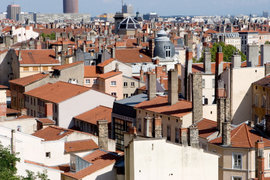
- Main article: Demographics of France
Since prehistoric times, France has been a crossroads of trade, migrations, and invasions. Four basic European ethnic stocks - Celtic (Gallic and Breton), Aquitanian (Basque related), Latin, and Germanic (Franks, Visigoths, Burgundians, Vikings) - have blended over the centuries to make up its present population. Besides these "historic" populations, new populations have migrated to France since the 19th century: Belgians, Italians, Spaniards, Portuguese, Poles, Armenians, Jews from Eastern Europe and the Maghreb, Arabs and Berbers from the Maghreb, Black Africans, and Chinese, to list only the most prominent. It is currently estimated that 40% of the French population descends from these different waves of migrations, making France the most ethnically diverse country of Europe, and quite comparable to the United States or Canada, despite the still popular stereotypes of France as an essentially Gallic country. Nevertheless, the immigrants from other European countries have an easier time blending in, while the 'non-European' groups tend to assimilate at a slower pace, because of racism and cultural differences.
Starting with the 19th century, the historical evolution of the population in France has been extremely atypical in the Western World. Unlike the rest of Europe, France did not experience a strong population growth in the 19th century and first half of the 20th century. On the other hand, it experienced a much stronger growth in the second half of the 20th century than the rest of Europe or indeed its own growth in the previous centuries.
After 1974, France's population growth stalled, and reached its nadir in the 1990s with only 0.39% annual growth, being now more in tune with the rest of Europe, which has entered demographic decline. However, first results from the 2004 French census have greatly surprised demographers. The census revealed that population growth rebounded significantly after the 1999 census, something nobody had anticipated. Between 1999-2003, annual population growth was 0.58%. In 2004, population growth was 0.68%, almost reaching North American levels. 2004 was the year with the highest increase in French population since 1974. France is now well ahead of all other European countries (except for the Republic of Ireland). In 2003, France's natural population growth (excluding immigration) was responsible for almost all the natural growth in European population: the population of the European Union increased by 216,000 inhabitants (without immigration), of which 211,000 was the increase in France's population alone, and 5,000 was the increase in all the other countries of the EU combined. In 2004 the natural increase in France's population reached 256,000, but figures for other European countries are not available yet.
These unexpected results bear great consequences for the future. At the moment, France is the third most populous country of Europe, behind Russia and Germany. By 2050, demographers initially thought the population of metropolitan France would be 64 million inhabitants, but they now agree that their estimates were too conservative, being based on the 1990s growth rate of population. Demographers now estimate that by 2050 metropolitan France's population will be 75 million, at which time it will be the most populated country of the European Union, above Germany (71 million), the United Kingdom (59 million), and Italy (43 million). If these estimates become reality, it may fundamentally alter the balance of power in Brussels. It would be the first time since the 1860s that France is the largest Nation of Europe (Russia excluded). In mid-2004 the EU had 460 million inhabitants, 13.6% of whom were living in France (including overseas départements). By 2050 it is estimated that the population of the European Union (of the current 25 members) will have declined to 445 million inhabitants, of whom 17.5% will be living in France.
According to the UNHCR, the number of people seeking political asylum in France rose by around 3 % between 2003 and 2004, while in the same period, the number of asylum applications submitted in the United States fell by about 29 %. France thereby replaced the United States as the world's top destination for asylum-seekers in 2004.
The sole official language of France is French. However, several regional languages (including Alsatian, Basque, Breton, Caribbean Creole, Catalan, Corsican, Flemish, Franco-Provençal dialects, Gascon, Lorraine German dialect, Occitan, and some Oïl dialects - e.g., Picard) are also occasionally understood and spoken, mostly by elderly people, but the French government and public school system discouraged the use of any of them until recently. These historical regional languages have been known as patois, though this has been considered depreciative. They are now taught at some schools, though French remains the only official language in use by the government, local or national. Some languages spoken by immigrants are also frequently spoken, especially in large cities: Portuguese, Maghreb Arabic, several Berber languages, several languages of Sub-Saharan Africa, Turkish, several spoken variants of Chinese (most notably Wu, Cantonese, Min Nan, and Mandarin), Vietnamese, and Khmer are the most frequently spoken.
At the 1999 census, INSEE sampled 380,000 adult people all across Metropolitan France, and asked them questions about their family situation. One of the questions was about the languages that their parents spoke with them before the age of 5. This is the first time serious statistics were computed about the proportion of mother tongues in France. The results were published in Enquête familiale, Insee, 1999.
If we add up people with mother tongue and people with some exposure to the language before the age of 5, then the five most important languages in metropolitan France are (note that the percentages add up to more than 100, because many people are now counted twice):
- French: 42,100,000 (92%)
- Oc languages: 1,670,000 (3.65%)
- German and German dialects: 1,440,000 (3.15%)
- Oïl languages: 1,420,000 (3.10%)
- Arabic: 1,170,000 (2.55%)
Culture
- Main article: Culture of France
- Académie française
- French literature
- French art
- List of French people
- Cuisine of France
- Cinema of France
- Music of France
- Holidays in France
Religion
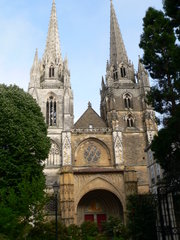
Traditionally a predominantly Roman Catholic country, with anticlerical leanings, France is since the 1970s a very secular country. Freedom of religion is a constitutional right, as reflected by the Declaration of the Rights of Man and of the Citizen. The dominant concept of the relationships between the public sphere and religions is that of laïcité, which implies that the government does not intervene in religious dogma, and that religions should refrain from intervening in policy-making. Tensions occasionally erupt about the alleged or real behaviour of some part of the Muslim minority, or about alleged or real discrimination against that community; see Islam in France.
The government does not maintain statistics as to the religion of its inhabitants. Statistics from an unspecified source and date given in the CIA World Factbook gives the following number: Roman Catholic 83 to 88%, Muslim 5 to 10%, Protestant 2%, Jewish 1%. However, in a 2003 poll 41% said that the existence of God was "excluded" or "unlikely". 33% declared that "atheist" described them rather or very well, and 51% said they were "Christian". When questioned about their religion, 62% answered Roman Catholic, 6% Muslim, 2% Protestant, 1% Jewish, 2% "other religions" (except for Orthodox or Buddhist, which were negligible), 26% "no religion" and 1% declined to answer. A Gallup poll established that 15% of the French population attend places of worship.
Military
- Main article: Military of France
The French armed forces are divided into four branches:
- Army (Armée de Terre)
- Navy (Marine Nationale)
- Air Force (Armée de l'Air)
- Gendarmerie (Gendarmerie Nationale), a military police force which serves for the most part as a rural and general purpose police force. Military age is 17. Since the Algerian War of Independence, conscription has been steadily reduced and was abolished by the government of Jacques Chirac in 1996.
Among the larger European economies, France and Britain are the only significant spenders on defence: France with 2.6% of GDP, and Britain, at 2.4%, according to 2003 figures from NATO. Those two countries account for 40% of EU defence spending. In most other EU countries, defence spending is less than 1.5% of GDP.
Miscellaneous topics
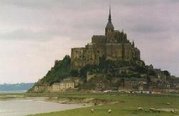
.jpg/180px-IMG_0133(Eiffel_in_Evening).jpg)
- Description of the flag: three equal vertical bands of blue (hoist side), white, and red became the flag during the French Revolution and made popular by Marquis de Lafayette; known as the drapeau tricolore (Tricolour Flag).
- The foundation of France is traditionally dated 496 (baptism of Clovis I). In reality, however, the legal founding of France is 843, date of the Treaty of Verdun, which divided the Frankish Empire and created the kingdom of Francia Occidentalis (“Western Frankland”), from which France is descended. The French state has been in continuous existence since 843, among the oldest states in existence in the world.
- France's motto "Liberté, Égalité, Fraternité" was first used as the rebels' motto during the French Revolution.
- The national holiday of France since 1880 is the Fête Nationale (National Holiday), colloquially known as le 14 juillet, celebrating the Fête de la Fédération (July 14, 1790) and not the storming of the Bastille (July 14, 1789) as is often mistakenly believed, even by a majority of French people, and is the reason why the holiday is referred to as Bastille Day in English. On the occasion of the Fête de la Fédération, celebrated exactly one year after the storming of the Bastille, all the representatives of the provinces of France gathered on the Champ de Mars in Paris in presence of the king Louis XVI and proclaimed the national unity of France. They vowed to remain faithful to "the Nation, the Law, the King".
- This day is considered by French Republicans as the real birth of France: France is no more a country made up of provinces conquered by kings, but a country of provinces and men who freely agree to form a common Nation. This concept of a Nation agreed upon is opposed to the German concept of a Nation based on ethnicity and race, and it was responsible for much of the conflicts between France and Germany in the end of the 19th century and beginning of the 20th century. Germany considered that Alsace was a German land that had been annexed by the conquest of the French kings, while France considered that although Alsace had indeed been a conquered province in the first place, it had legitimately and freely become a part of France by the oath of July 14, 1790. It is thus no surprise that the 14th of July was proclaimed the National Holiday of France in 1880, 9 years after Germany had detached Alsace-Lorraine from France.
- Despite being associated with the Fête de la Fédération, the 14th of July irked many French monarchists, to whom it recalled the bloody memory of the storming of the Bastille. French monarchists used to wear a black armband each 14th of July, in defiance of the National Holiday.
- The capital and most populous city, Paris, is considered by many to be one of the most famous and beautiful cities in the world. Paris is also home to numerous historical buildings and monuments.
- The Mont-Saint-Michel is the most visited tourist site in France. Other very popular and well-known tourist sites include: Louvre Museum, Eiffel Tower, Palace of Versailles, Disneyland Resort Paris, the châteaux of the Loire Valley, the ski resorts of the French Alps, Tahiti and the lagoons of French Polynesia, etc.
International rankings
- Total GDP, 2004: 5th (out of 184) (World Bank data)
- Total value of foreign trade (imports and exports), 2002: 4th (out of 185)
- Human Development Index, 2004: 16th (out of 177)
- Reporters Without Borders world-wide press freedom index 2004: Rank 19 out of 167 countries
- Transparency International Corruption Perceptions Index 2004 - 22nd of 145 countries
External links
Directories
- CIA- The World Factbook
- French Newspapers
- Official site of the French public service - Contains many links to various administrations and institutions
- White Pages - Residential phone numbers from France Télécom (does not include other operators)
- Yellow Pages - Business phone numbers from France Télécom
- Phonebook of France - City, Residential and Business Phonenumbers from Phonebook of the World
- Ferry to France
Maps and travel guides
- Map of France - Maps of France and its régions
Notes and references
- ^ For more information, see Category:French overseas departments, territories and collectivities
- ^ Rank by nominal GDP: 5 (2004); Rank by GDP per capita: 16 (2005); Rank by GDP at purchasing power parity per capita: 21 (2005).
- ^ According to a different calculation cited by the Pew Research Center, the EEZ of France would be 10,084,201 km² (3,893,532 mi²), still behind the United States (12,174,629 km² / 4,700,651 mi²), and still ahead of Australia (8,980,568 km² / 3,467,416 mi²) and Russia (7,566,673 km² / 2,921,508 mi²).
- ^ "Sénat - Statut des Sénateurs." Accessed August 31, 2005. page in French without apparent English version available
| International ties of the French Republic | ||
|---|---|---|
| Geographical and geopolitical: Continent of Europe | European Union | ||
| International organisations: United Nations | UN Security Council (permanent member) | NATO | OECD | OSCE | Group of 8 | ||

